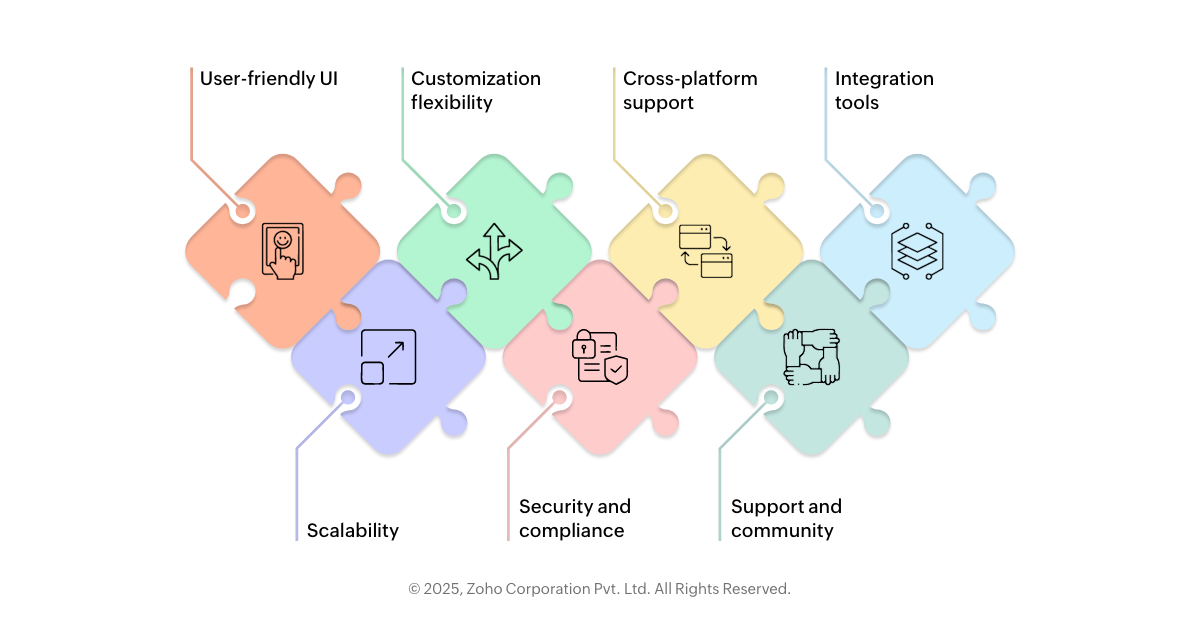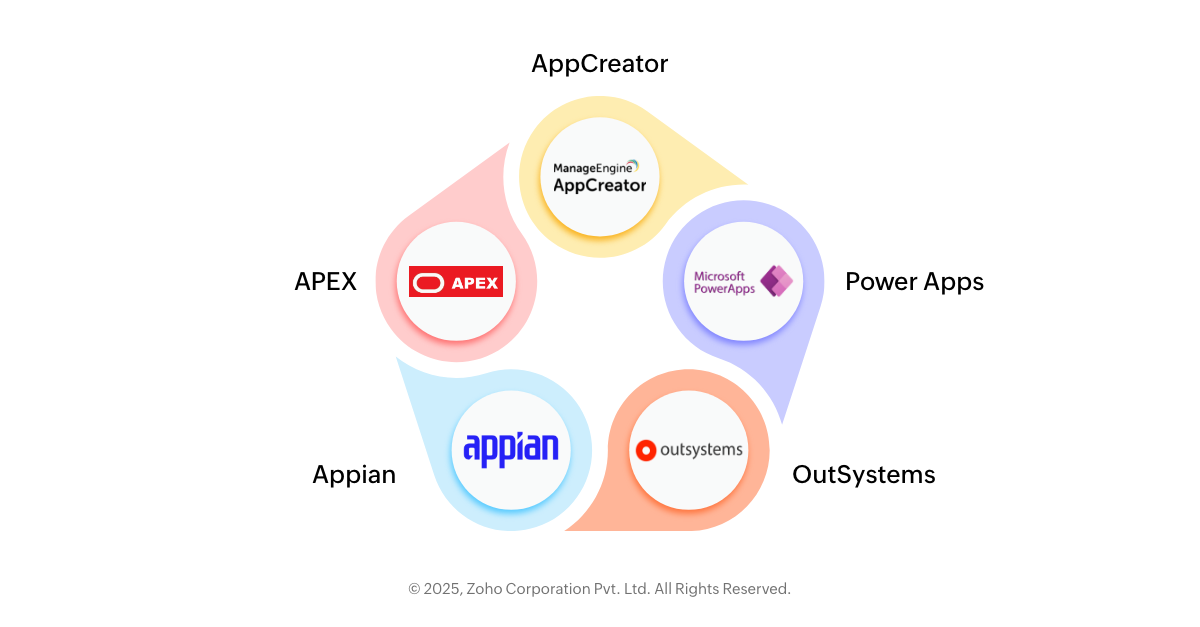- HOME
- Digital Transformation
- Best Mendix alternatives in 2025
Best Mendix alternatives in 2025
- Last Updated: February 1, 2025
- 90 Views
- 9 Min Read

Are you looking for a Mendix alternative? If so, you’ve come to the right place. While Mendix is a popular low-code platform, it may not always meet every business need.
In this blog, we’ll explore some key factors to consider when evaluating alternative platforms and offer an in-depth comparison of other platforms such as AppCreator, Power Apps, OutSystems, APEX, and Appian.
Whether you’re looking for better pricing, improved scalability, or specialized features, we’ll offer a comprehensive breakdown of each platform’s strengths and drawbacks.
Top reasons to look for Mendix alternatives
Mendix is a popular low-code platform, but there are several reasons why businesses might consider alternatives in 2025.
1. Learning curve and complexity: Mendix works well for developers, but it can be tricky for non-technical users to navigate. The steep learning curve may slow down adoption, particularly if business users are expected to create apps.
2. Pricing: When your application grows and requires more users, data storage, or advanced features, Mendix’s pricing model can become expensive. This could be a concern for startups or small businesses looking to scale affordably.
3. Use case suitability: Mendix is a powerful tool that can handle multiple use case scenarios, but businesses in specialized industries may find it beneficial to choose a solution built for their unique needs with specific features, such as advanced AI features or tailored templates.
4. Customization and flexibility: Despite its extensive feature-set, Mendix can be limiting if you need specialized features such as AI-powered data cleansing, a schema builder, or easy auto-validation, among others. Alternatives might offer more flexibility, better tools, or a more open framework for tailoring apps to your needs.
Key features to look for in a Mendix alternative
When evaluating Mendix alternatives, it's essential to focus on these key features:

1. User-friendly UI: A key feature to consider in a Mendix alternative is an intuitive, easy-to-use interface that streamlines app development. Choose platforms that offer drag-and-drop functionality to develop applications for non-technical users alongside custom coding options for technical users.
2. Customization flexibility: Ensure the platform supports extensive customization—through visual builders, API integrations, and custom coding—that addresses your specific business requirements. This flexibility allows for personalized solutions without the need for advanced development skills.
3. Cross-platform support: Seek platforms that facilitate seamless app deployment across web, mobile, and desktop, ensuring a consistent user experience. This cross-platform capability expands your reach and enhances accessibility for end users.
4. Integration tools: A strong alternative should provide built-in connectors or APIs for smooth integrations with third-party services, legacy systems, or databases. Seamless integration enhances app functionality and avoids silos within your business processes.
5. Scalability: The platform should be capable of supporting an expanding user base, larger data volumes, and additional features without compromising performance. Scalable solutions evolve with your business and maintain efficiency, even under high demand.
6. Security and compliance: Ensure the platform offers robust security features like encryption, role-based access, and compliance with industry standards like GDPR, SOC 2, and HIPAA. This helps safeguard sensitive data and ensures legal and regulatory adherence.
7. Support and community: Choose a platform with a reliable customer support team and a thriving developer community. A strong ecosystem brings access to helpful resources, troubleshooting solutions, and shared expertise, which can accelerate your development process and address issues swiftly.
These features will help you find a platform that meets both your technical and business requirements.
How is the Mendix alternatives list curated?
Curating the list of top Mendix alternatives for 2025 involved a thorough evaluation of platforms based on several critical factors. These factors ensure that businesses of all sizes can find the right solution for their needs.
Here are some important factors taken into account when compiling this list:
1. Ease of use: Ease of use in a low-code platform refers to an intuitive, user-friendly interface that allows users with little or no coding experience to build applications easily. Features like drag-and-drop components, visual builders, and pre-built templates make the development process quicker and more accessible to both technical and non-technical users.
2. Scalability: The ability to handle increasing data, user bases, and app complexity is a key consideration, ensuring that the applications built on these platforms can scale alongside your organization.
3. Integration capabilities: Our assessment prioritized platforms that offer smooth and efficient integrations with a wide range of third-party services and existing legacy systems. This enables seamless data exchange and improves overall efficiency of the platform.
4. Customization: Flexibility in customizing app features to meet business-specific needs was another key factor. This includes the ability to tailor functionalities, user interfaces, and processes to align with the unique requirements of different industries or business models.
5. Pricing flexibility: We considered cost-effectiveness, ensuring the alternatives offer scalable pricing models for businesses ranging from small and medium-sized businesses to enterprises.
By assessing these factors, we compiled a list of Mendix alternatives that provide a diverse range of options for businesses to explore.
Top 5 Mendix alternatives for 2025
It’s time to dive into the top 5 platforms you should be considering in 2025. In the table below, we’ve compiled a brief comparison of these alternatives.
This comparison will help you quickly evaluate which platform aligns with your business needs, whether you're a small startup or a large enterprise looking for flexibility, scalability, and ease of use.
Brand alternatives | Best for | Top feature | Free plan | Pricing | Migration |
AppCreator | Mid to large organizations and enterprises |
| Yes: 30-day trial | Annually: $1,995 (depending on features and scale) | Easy to moderate migration difficulty. Depends on the complexity of the solutions and integrations |
Power Apps | Mid to large enterprises, especially those using Microsoft tools | Deep integration with the Microsoft ecosystem | Yes: Free plan with limited functionality | Monthly: $20 per user | Generally easy within a predominantly Microsoft ecosystem, but may face complexity with non-Microsoft tools |
OutSystems | Large enterprises, particularly in need of scalable and complex solutions | Good performance, enterprise-grade scalability, and flexibility | No: Free trail is currently unavailable | Annually: $36,300 per year for enterprise plans | High ease of migration with well-defined migration tools, especially for large-scale enterprise apps |
Appian | Mid to large enterprises, particularly in regulated industries (finance, healthcare, etc) | Business process management (BPM) and case management | Yes: Appian community edition | Supports easy migration, especially for businesses looking for BPM and workflow automation | |
APEX | High integration capabilities with Oracle databases and cloud services | High integration capabilities with Oracle databases and cloud services | Yes: Free plan with limited features | Monthly: Starts at $122 per month | Easy migration within Oracle environments. For non-Oracle users, data migration can be complex |
Analysis of top Mendix alternatives
Let’s dive deep into the comparison and explore how these platforms stack up against each other.

1. ManageEngine AppCreator
MangeEngine AppCreator is a low-code application development platform that helps you build custom applications from scratch, tailored to fit your business needs. Designed for both technical and non-technical users alike, AppCreator simplifies app creation through an intuitive drag-and-drop interface and prebuilt templates, thus making it faster and easier for users to design and deploy apps.
With AppCreator, you can easily integrate with internal and external systemsand services, thanks to its support for multiple APIs and data sources. The platform is highly customizable, enabling you to personalize both the user interface and processes to fit your organization's needs, ensuring a tailored solution for your organization.
Top features
- Visual development: AppCreator provides a robust set of visual development tools, including a form builder that lets you easily drag and drop over 30 types of form fields to collect information such as names, email addresses, and customer feedback. Additionally, it features an analytics and dashboard builder that enables you to create interactive reports and dashboards. This tool helps you consolidate data from multiple sources and add a variety of charts and widgets, making your data clearer and more accessible.
- Advanced automation: The advanced automation tools allow users to create custom workflows using Deluge, Zoho's low-code scripting language. The platform also provides schedulers, reminders, and notifications to handle tasks—such as sending reports, sending event invitations, and setting deadline alerts—ensuring that tasks stay on track.
- Analytics: With analytics, users can gain insights from AppCreator’s various reporting tools—such as spreadsheets, lists, and calendars, among others—along with dashboards. The built-in filtering options make it simple to sort and access the data you need. Customizable dashboards also enable you to monitor key performance indicators in one central location, providing a clear overview of your progress.
- Multi-device solutions: AppCreator lets you design apps for web, phone, and tablet at once, accessible via browser or as progressive web apps. You can personalize apps with custom icons and publish them to the Play store and App store. It also offers a mobile SDK and UI kit for building native iOS and Android apps for your enterprise.
- Security: You can share entire applications or specific sections through a public link or private email within your organization. Role-based access ensures that users only see the forms and reports relevant to their assigned permission sets. Additionally, record auditing lets you monitor changes by showing who made edits and when.
Pros
- Highly secure.
- Cross-platform app development is easy.
- User-friendly and responsive interface.
- Extensive customization capabilities.
- Easy integration with internal or other third-party platforms and databases.
Cons
- Familiarity with Deluge to perform advanced customizations.
Pricing
AppCreator is priced at $1,995 annually, with the cost varying depending on the features and scale required by your organization.
2. Microsoft Power Apps
Microsoft Power Apps is a low-code platform that allows users to build apps using minimal to low coding. It seamlessly integrates with other Microsoft services like Excel, OneDrive, and SharePoint, along with cloud services like Google Drive. Apps are designed on a canvas, similar to PowerPoint slides, and data is securely stored in the Common Data Service(CDS) within entities. The platform is user-friendly, making it easy to create and share business apps. Additionally, with Portals, you can build websites that allow you to interact with the data stored in the CDS.
Pros
- User-friendly for non-developers.
- Strong integration capabilities, especially along with other Microsoft products.
Cons
- Dependency on other Microsoft products , Power Apps works best within the Microsoft ecosystem and relies heavily on integrations with other Microsoft services.
- Restrictive design options.
Pricing
Power Apps offers a subscription-based pricing model, starting from $20 per user per month for basic features.
3. OutSystems
OutSystems is an enterprise-grade low-code platform that empowers businesses to rapidly build, deploy, and manage sophisticated applications across various industries. With a focus on scalability, robust security features, and fast development cycles, it is well-suited for large organizations seeking to create highly customizable apps. Its ability to integrate seamlessly with existing systems and scale along with the organization makes it a preferred solution among enterprises.
Pros
- Rapid development cycle.
- Suitable for teams of IT developers who want to prototype rapidly.
Cons
- Steep learning curve for beginners.
- Pricing can be expensive for smaller businesses.
Pricing
OutSystems offers enterprise plans starting at $36,300 annually.
4. Appian
A seasoned player in low-code development, Appian empowers both professional and citizen developers with its intuitive visual builders to create apps quickly. Appian allows users to build applications easily across web and mobile devices. The platform also supports custom code using SAIL, along with other scripting languages like Java or Python as needed. Appian accelerates app development with AI, enabling the use of generative models or custom AI solutions. It ensures engaging user experiences across all devices while eliminating data silos by optimizing enterprise data.
Pros
- Easy to use.
- Building cross-platform apps is easy.
Cons
- Limited integrations with third-party platforms and applications.
- Appian's debugging tools are less robust than those found in traditional development environments, making troubleshooting difficult—especially in complex applications.
Pricing
Appian offers tiered pricing based on usage, features, and requirements.
5. APEX
Oracle APEX is a widely-recognized enterprise level low-code platform. It allows users to build scalable and secure web and mobile applications with advanced features, suitable for deployment both in the cloud and on-premises. The platform’s robust development environment accelerates the app creation process, making it easier for organizations to deliver high-quality solutions quickly and efficiently.
Pros
- Highly secure.
- Ability to build extensively scalable applications.
Cons
- Oracle APEX is tightly integrated with the Oracle technology stack, which can be a disadvantage for organizations using a different database system.
- Requires knowledge of coding in APEX for deeper customization.
Pricing
APEX pricing starts at $122 per month, offering flexible plans to suit different business needs.
Summary
The big question is, "Is there a single best low-code platform for every organization?"
The short answer is no. There's no universal solution, as each organization has its own distinct processes and requirements; hence, some platforms may be a better fit than others.
If you're looking for an enterprise-level low-code platform with advanced AI-driven development tools, OutSystems is a great choice. For seamless integration with Microsoft products, Power Apps offers a user-friendly solution. If business process management (BPM) is a priority, Appian is highly suited. For organizations needing both cloud and on-premises deployment options, APEX is a platform worth exploring.
We suggest considering ManageEngine AppCreator if you're looking for a user-friendly low-code platform that combines intuitive visual builders with custom coding options, like Deluge, for more advanced functionality. The platform offers strong integration capabilities, allowing you to seamlessly connect with various third-party tools and services. Additionally, the platform prioritizes security with features like data encryption and role-based access controls, ensuring compliance with regulations such as GDPR and HIPAA to protect sensitive data and meet industry standards. This makes AppCreator a reliable solution for both organizations and enterprises.
If you would like to explore AppCreator further, we invite you to sign up for a free trial and evaluate how the platform aligns with your requirements.




